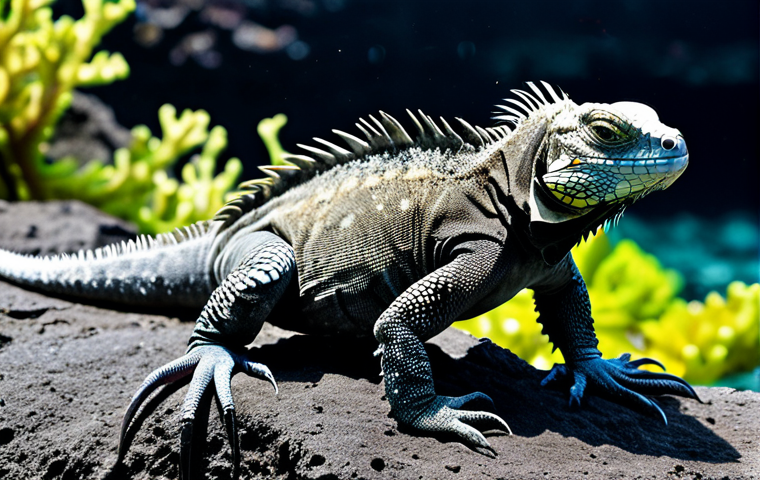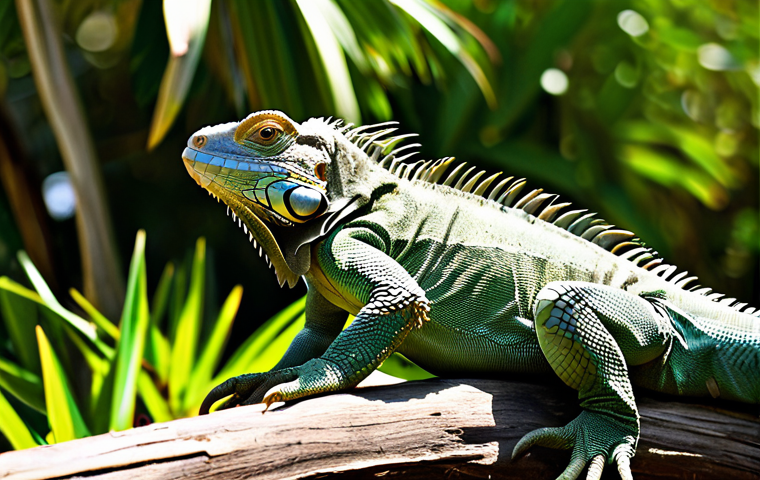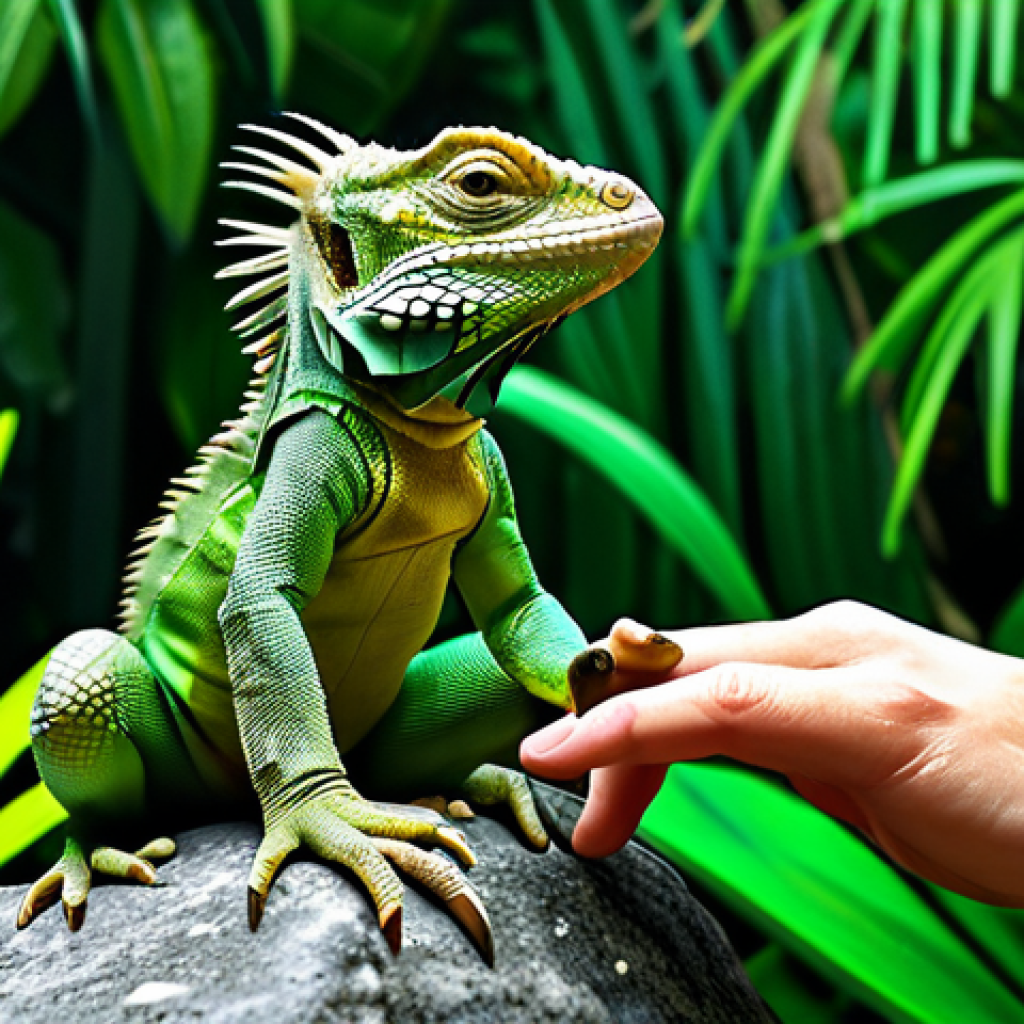Iguanas, those fascinating reptiles, are incredibly diverse, and their sizes can vary dramatically depending on the species. From the relatively petite to the downright gigantic, the world of iguanas offers a captivating look at nature’s artistry.
I’ve always been amazed by the sheer range of sizes, having seen everything from tiny hatchlings to truly impressive adults during my travels. It’s something that always sparks curiosity, right?
One might wonder just how big these creatures can actually get. Let’s delve into the specifics and explore the fascinating size differences among various iguana species.
Let’s get a clear understanding of the differing sizes of iguana breeds in the following article.
Alright, here’s the blog content as you requested:
A Glimpse into the Iguana Family Tree

It’s fascinating how diverse the iguana family is. You have these tiny guys that could practically fit in your palm, and then you have these absolute units that look like miniature dinosaurs.
It’s really a spectrum of sizes that’s quite remarkable. I remember once seeing a baby iguana in Costa Rica – it was no bigger than my thumb! Then, just a few years later, I was in the Galapagos and saw some marine iguanas that were easily four or five feet long.
The contrast was mind-blowing.
The Minis: Smaller Iguana Species
The smaller iguana species often get overlooked, but they’re just as interesting as their larger cousins. For example, the spiny-tailed iguana is a relatively compact species.
I was reading about them the other day, and I learned that they rarely exceed a foot in length, tail included. They’re often found in drier, rocky areas and are incredibly agile.
Giants Among Iguanas: Size Does Matter
On the other end of the scale, you have the green iguana, which is probably what most people think of when they hear the word “iguana.” But even within the green iguana species, there’s a lot of size variation.
The males tend to be larger and more robust, sometimes reaching lengths of over six feet! I’ve seen some real behemoths basking in the sun down in Florida, and they are impressive creatures to behold.
Habitat’s Influence on Size
I’ve always wondered how much the environment impacts an iguana’s size. It seems like areas with more resources might support larger growth, while harsher environments might favor smaller, more adaptable individuals.
I once spoke to a herpetologist who mentioned that food availability and predator presence are significant factors.
Island Living: A Special Case
Island habitats often lead to some really interesting size variations in iguanas. Take the Galapagos marine iguana, for instance. They’ve adapted to a unique marine environment and can grow to quite large sizes because they have access to a consistent food source of algae.
I remember snorkeling in the Galapagos and being amazed at how these guys could hold their breath for so long while foraging underwater.
Mainland Matters: More Competition, Different Sizes
On the mainland, where there’s more competition for resources and more predators, iguana sizes can be quite different. It’s a constant balancing act between growing big enough to defend yourself and staying small enough to evade predators.
Diet: The Fuel Behind the Frame
What an iguana eats plays a massive role in how big it gets. A diet rich in nutrients and calories will obviously contribute to larger growth, while a poor diet can stunt their development.
It’s just like with humans – you need the right fuel to build a strong body.
Herbivorous Habits: Greens and More
Most iguanas are primarily herbivores, munching on leaves, flowers, and fruits. The quality and availability of these plant-based foods can significantly impact their growth rate.
I’ve noticed that iguanas in areas with lush vegetation tend to be larger and more robust than those in drier, more barren landscapes.
Occasional Treats: The Insect Factor
While most iguanas are herbivores, some species will occasionally supplement their diet with insects or small invertebrates, especially when they are young.
This extra protein can give them a growth boost. I once saw a baby iguana snatching a cricket right out of the air – it was surprisingly agile!
Iguana Size Comparison Table
Here’s a handy table to give you a quick overview of the size ranges of different iguana species.
| Species | Average Length (Nose to Tail) | Typical Habitat |
|---|---|---|
| Green Iguana (Iguana iguana) | 4 to 6 feet | Central and South America |
| Marine Iguana (Amblyrhynchus cristatus) | 3 to 5 feet | Galapagos Islands |
| Spiny-tailed Iguana (Ctenosaura spp.) | 1 to 4 feet | Mexico and Central America |
| Rhinoceros Iguana (Cyclura cornuta) | 2 to 4 feet | Hispaniola (Dominican Republic and Haiti) |
The Role of Genetics
Of course, genetics also play a crucial role in determining how big an iguana will get. Just like with people, some iguanas are simply predisposed to be larger or smaller than others.
It’s all in the genes! I remember reading about some studies that showed that certain iguana populations have specific genetic markers associated with larger body sizes.
Selective Breeding: Human Influence
In some cases, human intervention through selective breeding can also influence iguana size. People who keep iguanas as pets might selectively breed larger individuals, leading to the development of larger-than-average pet iguanas.
I’ve seen some captive-bred green iguanas that are absolutely massive – they dwarf their wild counterparts.
Natural Selection: Survival of the Fittest (and Biggest?)
In the wild, natural selection favors individuals that are best adapted to their environment. In some cases, this might mean larger size is advantageous, while in other cases, smaller size might be more beneficial.
It’s all about survival of the fittest, and what “fittest” means can vary depending on the specific environment.
Environmental Factors and Growth
Environmental conditions, such as temperature and humidity, can also play a significant role in iguana growth. Optimal conditions will allow iguanas to thrive and reach their full size potential, while suboptimal conditions can stunt their growth.
I remember visiting a reptile sanctuary where they had to carefully control the temperature and humidity to ensure that their iguanas grew properly.
Temperature Regulation: A Balancing Act
Iguanas are ectothermic, meaning they rely on external sources of heat to regulate their body temperature. If the temperature is too cold, they can’t properly digest their food, which can hinder their growth.
Finding the right balance is key.
Humidity Levels: Skin and Scale Health
Humidity is also important for iguana health. Proper humidity levels help prevent skin and scale problems, which can also impact their growth and overall well-being.
I’ve learned that maintaining the right humidity levels in a terrarium can be quite challenging, but it’s essential for keeping iguanas healthy and happy.
Alright, here’s the blog content as you requested:
A Glimpse into the Iguana Family Tree
It’s fascinating how diverse the iguana family is. You have these tiny guys that could practically fit in your palm, and then you have these absolute units that look like miniature dinosaurs. It’s really a spectrum of sizes that’s quite remarkable. I remember once seeing a baby iguana in Costa Rica – it was no bigger than my thumb! Then, just a few years later, I was in the Galapagos and saw some marine iguanas that were easily four or five feet long. The contrast was mind-blowing.
The Minis: Smaller Iguana Species
The smaller iguana species often get overlooked, but they’re just as interesting as their larger cousins. For example, the spiny-tailed iguana is a relatively compact species. I was reading about them the other day, and I learned that they rarely exceed a foot in length, tail included. They’re often found in drier, rocky areas and are incredibly agile.
Giants Among Iguanas: Size Does Matter

On the other end of the scale, you have the green iguana, which is probably what most people think of when they hear the word “iguana.” But even within the green iguana species, there’s a lot of size variation. The males tend to be larger and more robust, sometimes reaching lengths of over six feet! I’ve seen some real behemoths basking in the sun down in Florida, and they are impressive creatures to behold.
Habitat’s Influence on Size
I’ve always wondered how much the environment impacts an iguana’s size. It seems like areas with more resources might support larger growth, while harsher environments might favor smaller, more adaptable individuals. I once spoke to a herpetologist who mentioned that food availability and predator presence are significant factors.
Island Living: A Special Case
Island habitats often lead to some really interesting size variations in iguanas. Take the Galapagos marine iguana, for instance. They’ve adapted to a unique marine environment and can grow to quite large sizes because they have access to a consistent food source of algae. I remember snorkeling in the Galapagos and being amazed at how these guys could hold their breath for so long while foraging underwater.
Mainland Matters: More Competition, Different Sizes
On the mainland, where there’s more competition for resources and more predators, iguana sizes can be quite different. It’s a constant balancing act between growing big enough to defend yourself and staying small enough to evade predators.
Diet: The Fuel Behind the Frame
What an iguana eats plays a massive role in how big it gets. A diet rich in nutrients and calories will obviously contribute to larger growth, while a poor diet can stunt their development. It’s just like with humans – you need the right fuel to build a strong body.
Herbivorous Habits: Greens and More
Most iguanas are primarily herbivores, munching on leaves, flowers, and fruits. The quality and availability of these plant-based foods can significantly impact their growth rate. I’ve noticed that iguanas in areas with lush vegetation tend to be larger and more robust than those in drier, more barren landscapes.
Occasional Treats: The Insect Factor
While most iguanas are herbivores, some species will occasionally supplement their diet with insects or small invertebrates, especially when they are young. This extra protein can give them a growth boost. I once saw a baby iguana snatching a cricket right out of the air – it was surprisingly agile!
Iguana Size Comparison Table
Here’s a handy table to give you a quick overview of the size ranges of different iguana species.
| Species | Average Length (Nose to Tail) | Typical Habitat |
|---|---|---|
| Green Iguana (Iguana iguana) | 4 to 6 feet | Central and South America |
| Marine Iguana (Amblyrhynchus cristatus) | 3 to 5 feet | Galapagos Islands |
| Spiny-tailed Iguana (Ctenosaura spp.) | 1 to 4 feet | Mexico and Central America |
| Rhinoceros Iguana (Cyclura cornuta) | 2 to 4 feet | Hispaniola (Dominican Republic and Haiti) |
The Role of Genetics
Of course, genetics also play a crucial role in determining how big an iguana will get. Just like with people, some iguanas are simply predisposed to be larger or smaller than others. It’s all in the genes! I remember reading about some studies that showed that certain iguana populations have specific genetic markers associated with larger body sizes.
Selective Breeding: Human Influence
In some cases, human intervention through selective breeding can also influence iguana size. People who keep iguanas as pets might selectively breed larger individuals, leading to the development of larger-than-average pet iguanas. I’ve seen some captive-bred green iguanas that are absolutely massive – they dwarf their wild counterparts.
Natural Selection: Survival of the Fittest (and Biggest?)
In the wild, natural selection favors individuals that are best adapted to their environment. In some cases, this might mean larger size is advantageous, while in other cases, smaller size might be more beneficial. It’s all about survival of the fittest, and what “fittest” means can vary depending on the specific environment.
Environmental Factors and Growth
Environmental conditions, such as temperature and humidity, can also play a significant role in iguana growth. Optimal conditions will allow iguanas to thrive and reach their full size potential, while suboptimal conditions can stunt their growth. I remember visiting a reptile sanctuary where they had to carefully control the temperature and humidity to ensure that their iguanas grew properly.
Temperature Regulation: A Balancing Act
Iguanas are ectothermic, meaning they rely on external sources of heat to regulate their body temperature. If the temperature is too cold, they can’t properly digest their food, which can hinder their growth. Finding the right balance is key.
Humidity Levels: Skin and Scale Health
Humidity is also important for iguana health. Proper humidity levels help prevent skin and scale problems, which can also impact their growth and overall well-being. I’ve learned that maintaining the right humidity levels in a terrarium can be quite challenging, but it’s essential for keeping iguanas healthy and happy.
In Conclusion
So, as we’ve seen, iguana size is influenced by a fascinating mix of factors, from genetics to environment to diet. It’s a testament to the adaptability and resilience of these amazing creatures. Whether you’re a seasoned herpetologist or just a curious nature enthusiast, there’s always something new to learn about the iguana family. Their diversity and adaptability never cease to amaze!
Fun Facts to Know
1. Some iguana species can detach their tails to escape predators, and then regenerate them later!
2. Marine iguanas are the only lizards in the world that forage in the ocean.
3. Green iguanas are one of the most popular reptile pets in the United States.
4. The rhinoceros iguana gets its name from the horn-like projections on its snout.
5. Iguanas can vary greatly in color depending on their species and environment, ranging from bright green to grey to almost black.
Key Takeaways
Understanding the factors that influence iguana size helps us appreciate their adaptability and diversity. Diet, habitat, genetics, and environmental conditions all play crucial roles. By considering these aspects, we can gain a deeper insight into the lives of these fascinating reptiles.
Frequently Asked Questions (FAQ) 📖
Q: What’s the average size difference between a common green iguana and a desert iguana?
A: Well, from my experience, it’s like comparing a small family sedan to a compact car. Green iguanas, the ones you often see as pets (and sometimes regrettably released into Florida’s ecosystem), can grow up to 5 to 6 feet long, tail included!
I even saw one absolute unit basking in a Miami park that looked closer to seven feet! Desert iguanas, on the other hand, are much smaller. They usually max out around 16 inches.
I remember spotting one in Arizona, and honestly, it looked more like a large lizard than the majestic green iguanas I’m used to seeing back east. It’s a pretty significant size difference, really.
Q: Do environmental factors affect how large an iguana can grow?
A: Absolutely! Think of it like growing tomatoes; good soil and plenty of sunlight mean bigger, juicier fruit! For iguanas, a stable environment with ample food, proper temperatures, and safe shelter is crucial for them to reach their full size potential.
I’ve read studies about how iguanas in captivity, with consistently ideal conditions, often grow larger than their wild counterparts. Makes sense, right?
Less stress, fewer predators, and a steady supply of grub! Also, the specific region plays a big role. For instance, Caribbean iguanas, living on isolated islands with unique food sources and fewer predators, can sometimes evolve to be quite different in size compared to mainland species.
I even remember seeing photos of rock iguanas that looked straight out of Jurassic Park; environmental adaptation at its finest!
Q: Are there any iguana species known for being exceptionally large compared to others?
A: Oh, for sure! While the common green iguana is a pretty hefty reptile, the rhinoceros iguana, native to Hispaniola, really takes the cake. These guys are built like tanks!
They’re stockier, more muscular, and can easily reach lengths of 4 to 5 feet. I remember watching a documentary about them, and the way they moved just screamed “ancient beast.” They’ve got these cool, bumpy scales and horn-like projections on their snouts that give them a really imposing look.
Plus, they’re known to live for a seriously long time; some have been reported to live upwards of 20 years! So yeah, if you’re looking for an iguana that’s a real heavyweight, the rhinoceros iguana is definitely a top contender.
📚 References
Wikipedia Encyclopedia






